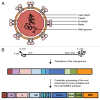STAT2 signaling and dengue virus infection
- PMID: 24778924
- PMCID: PMC3995738
- DOI: 10.4161/jkst.27715
STAT2 signaling and dengue virus infection
Abstract
Dengue virus (DENV) is an important human pathogen whose byzantine relationship with the immune response is poorly understood. DENV causes dengue fever and dengue hemorrhagic fever/dengue shock syndrome, diseases for which palliative care is the only treatment. DENV immunopathogenesis studies are complicated by the lack of an immunocompetent small-animal model, and this has hindered anti-DENV drug and vaccine development. This review describes strategies that DENV uses to evade the type I interferon response and focuses on how data gained from the study of DENV NS5-mediated STAT2 degradation may be used to create immunocompetent DENV mouse models and design anti-DENV therapeutics.
Keywords: NS5; STAT2; antagonism; dengue virus; host tropism; interferon; mouse model.
Figures


Similar articles
-
Host-Specific NS5 Ubiquitination Determines Yellow Fever Virus Tropism.J Virol. 2019 Jun 28;93(14):e00151-19. doi: 10.1128/JVI.00151-19. Print 2019 Jul 15. J Virol. 2019. PMID: 31043530 Free PMC article.
-
Dengue virus co-opts UBR4 to degrade STAT2 and antagonize type I interferon signaling.PLoS Pathog. 2013 Mar;9(3):e1003265. doi: 10.1371/journal.ppat.1003265. Epub 2013 Mar 28. PLoS Pathog. 2013. PMID: 23555265 Free PMC article.
-
Structural modeling and analysis of dengue-mediated inhibition of interferon signaling pathway.Genet Mol Res. 2015 Apr 28;14(2):4215-37. doi: 10.4238/2015.April.28.4. Genet Mol Res. 2015. PMID: 25966194
-
Innate immunity evasion by Dengue virus.Viruses. 2012 Mar;4(3):397-413. doi: 10.3390/v4030397. Epub 2012 Mar 15. Viruses. 2012. PMID: 22590678 Free PMC article. Review.
-
Innate immunity to dengue virus infection and subversion of antiviral responses.J Mol Biol. 2014 Mar 20;426(6):1148-60. doi: 10.1016/j.jmb.2013.11.023. Epub 2013 Dec 3. J Mol Biol. 2014. PMID: 24316047 Free PMC article. Review.
Cited by
-
Regulation of Flavivirus RNA synthesis and replication.Curr Opin Virol. 2014 Dec;9:74-83. doi: 10.1016/j.coviro.2014.09.011. Epub 2014 Oct 17. Curr Opin Virol. 2014. PMID: 25462437 Free PMC article. Review.
-
Mobilization and Activation of the Innate Immune Response to Dengue Virus.Front Cell Infect Microbiol. 2020 Nov 3;10:574417. doi: 10.3389/fcimb.2020.574417. eCollection 2020. Front Cell Infect Microbiol. 2020. PMID: 33224897 Free PMC article. Review.
-
Dengue virus and the host innate immune response.Emerg Microbes Infect. 2018 Oct 10;7(1):167. doi: 10.1038/s41426-018-0168-0. Emerg Microbes Infect. 2018. PMID: 30301880 Free PMC article. Review.
-
Innate Immune Antagonism of Mosquito-Borne Flaviviruses in Humans and Mosquitoes.Viruses. 2021 Oct 20;13(11):2116. doi: 10.3390/v13112116. Viruses. 2021. PMID: 34834923 Free PMC article. Review.
-
Regulation of Host Innate Immunity by Non-Coding RNAs During Dengue Virus Infection.Front Cell Infect Microbiol. 2020 Nov 30;10:588168. doi: 10.3389/fcimb.2020.588168. eCollection 2020. Front Cell Infect Microbiol. 2020. PMID: 33330133 Free PMC article. Review.
References
-
- WHO. Dengue and severe dengue. Fact Sheet Number 117: World Health Organization, 2013.
Publication types
LinkOut - more resources
Full Text Sources
Other Literature Sources
Research Materials
Miscellaneous
